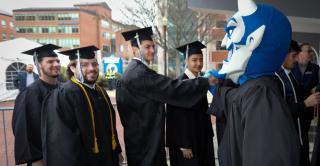
By Savanna Yelling ’25
Central Connecticut State University is steadily advancing its mission to create a greener campus and reduce its carbon footprint. While the university’s ultimate goal is to achieve climate neutrality by 2050, recent changes in energy, infrastructure, and student involvement reflect a growing commitment to sustainability.
Central’s work thus far has gained national recognition. The university was named to the Princeton Review’s 2025 Green Colleges list, which cited Central’s sustainability committee, sustainability-focused degree, a designated sustainability officer and public greenhouse gas inventory plan.
“Central is committed to sustainability,” President Zulma R. Toro said. “This is part of our Strategic Plan and mission to be good citizens and help preserve the environment."
Leading these efforts is Pano Koukopoulos, the new director of Environmental Health and Safety at Central, who is working to expand sustainability initiatives across campus.
Investing in energy and infrastructure
Across campus, several major upgrades showcase progress. Central now purchases a portion of its electricity from green sources, reducing dependence on fossil fuels.
“Every time we renovate a space, energy conservation is at the forefront,” Koukopoulos said.
The university also has prioritized sustainable construction. New and renovated buildings, including the recently completed Applied Innovation Hub, meet LEED Gold or High-Performance standards. These energy-efficient designs align with Connecticut state law and Central’s own sustainability goals.
Sustainability on campus is visible beyond large-scale projects as well. The Sunbolt Campus XL, a solar-powered charging station outside of Devil’s Den, allows devices to be charged using energy from the sun. The Bloom Energy Server Platform, located between Kaiser Hall and the Copernicus Parking Garage, houses Central’s fuel cells.
Sustainable transportation is becoming more accessible as there are currently 22 electric vehicle charging stations in place, with more on the way. Current EV charger locations are marked on the latest digital campus map at https://www.ccsu.edu/campusmap.
Meanwhile, there are energy upgrades being made even in unseen parts of campus. The campus is connected via a labyrinth of tunnels, and the university is working to implement green practices, even underground, Koukopoulos said.
Central also is reducing landfill waste by disposing of food waste sustainably. The biodigester system converts organic food scraps into biogas and fertilizer, reducing the amount of food waste that ends up in landfills.
“We have a food waste diversion [program]. Memorial Hall has designated bins... and that goes to a biodigester,” Koukopoulos said.
Keeping PACE with goals
The President’s Advisory Committee on Environmental Sustainability (PACES), is a university-wide committee tasked with advising the president on progress toward goals. Established in 2007, PACES aims to embed sustainability into campus operations and long-term planning.
“PACES was established in 2007 to bring together the campus community to advise the university president on the best ways to achieve environmental sustainability,” Toro said. “That important work continues and has resulted in many of the green initiatives around campus, whether it’s the solar charging station, fuel cell installation, or electric charging stations in the parking lots.”
Student and community engagement
Climate-consciousness is also growing in the classrooms. Central offers both Bachelor of Arts and Bachelor of Science programs in Climate Change Studies, preparing students to become leaders in sustainability.
Students are playing a role in shaping a greener future as well. The Sustainability Club, recently revived by junior environmental science major Alison Correia, holds regular meetings and prepares to host and participate in events on campus.
“Sustainability is important everywhere,” Correia said. “Climate change is a global existential crisis. We all have the responsibility to address it to the absolute best of our abilities. Promoting sustainability on campus sets an example to the students while also showing that we care about their current and future well-being.”
Student-led projects are making an impact, too. The Sustainability Club hosts the Blue Devil Move-Out Drive in collaboration with Environmental Health and Safety, collecting donations from resident students when they move off campus and donating them to local non-profits. This not only aids the community, but it prevents unwanted items from winding up in landfills.
While there are many initiatives underway, some students are still eager for the university to keep this momentum going.
“I would like to see solar panels installed and the campus able to run on 100 percent renewable energy and see the elimination of single-use disposables from dining,” Correia said.
Everyday actions matter
Even small habits can make a difference. Koukopoulos said he recommends that people implement daily practices that will reduce their environmental footprint, from something as simple as turning off lights in an empty room to placing recyclables in one of the many bins on campus. Other tips include:
• Unplug chargers from outlets. Wall chargers are energy thieves and consume energy even when the device they charge has been unplugged
• Turn off the water when doing dishes or brushing teeth. Turn on the faucet when rinsing.
• Limit the time in the shower. Take it a step further by turning off the water when lathering and turning it back on to rinse off the suds
• Use a reusable water bottle. There are numerous water refilling stations around campus
• Close the windows when the heat or the AC is on. If the room is uncomfortably warm or cold, let someone know. Sometimes the thermostat settings may need to be reset.
• Limit the number of printed materials used
• Walk/bike a little more and drive a little less
• If possible, take the stairs instead of the elevator
• Educate yourself and learn how you can be a part of the solution



